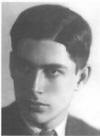Poesie života [Poetry of Life], 12 songs on texts by Renata
Horalová, for soprano and quarter-tone guitar, op.53, [pp. 21], FKM Filmkunst-Musikverlag, Munich,
[translation of Poesie života in appendix 1].
1) Poesie života [Poetry of Life];
2) Procitnutí jara [Spring Awakening];
3) Z dívčího kalendáře [From a Girl's Calendar];
4) Jaro života [Spring of Life];
5) Až [When];
6) Dvojzpěv [Duo];
7) Jablo [The Apple Tree];
8) Broskve [Peaches];
9) Slova lásky [Words of Love];
10) Hřích lásky (Početí) [Sin of Love (Conception)];
11) Ukolčbavka [Lullaby];
12) Modlitba v podletí [Prayer towards Summer].
Written in the quarter-tone system, it was composed from October 4 to 31, 1943. The frontispiece also indicates the duration: 32 minutes. The guitar supports the singing with a constant, dense, and rather prominent writing style.
A large-scale work combines some of the peculiar themes of the Czech composer. In this case, Horalová's text becomes the network to filter an ethical function of music, themes that Hába has always considered of great importance.
Poetry of Life
Men walk along steep paths
one day after another passes
and one of them thinks
of seeking poetry.
Men walk in the wind of life
that lashes their faces
and even in those vain days
man glimpses some poetry.
And dreams of fragile joys
that live only in dreams.
I never make fragile dreams
my poetry is poor.
The wombs of mothers that bloom
when life is sown in them
are for me, oh reader of my verses,
the greatest poetry.
from: Renata Horalová, Přess Kořeny neseno - lyrical and epic poetry from Vysočina, CE"eská Akademie Věd a Umění, Prague [1943].

Poesie života, for quarter-tone guitar and soprano
 The guitar work of Alois Hába spans about five years: from 1943 to 1947, during the period when he was a
composition professor at the Prague Conservatory.
Let us remember that at the Prague Conservatory, the guitar and lute course began in 1928 with Antonín
Modr and after 1936 with Stěpán Urban, who later became Hába's direct collaborator.
The main source of Hába's guitar catalog, reported here, is the monograph by Jiří Vysložil and the
documentation from the Hába Center in Prague directed by Jan Andreska.
The guitar work of Alois Hába spans about five years: from 1943 to 1947, during the period when he was a
composition professor at the Prague Conservatory.
Let us remember that at the Prague Conservatory, the guitar and lute course began in 1928 with Antonín
Modr and after 1936 with Stěpán Urban, who later became Hába's direct collaborator.
The main source of Hába's guitar catalog, reported here, is the monograph by Jiří Vysložil and the
documentation from the Hába Center in Prague directed by Jan Andreska.
Hába relied on Franz Metall for the construction of quarter-tone guitars, who built several quarter-tone instruments. These guitars feature a double fretboard division. Unfortunately, only a few models were built, so the performances (known to us) were rather isolated, and to this day, the entire body of work requires extensive study.
Here is Hába's work for and with guitar:
Dětské nálady ( Children's Moods ) for medium voice and quarter-tone guitar, op.51 (1943);
Sonata for guitar, op.52, (1943);
Poesie života for soprano and quarter-tone guitar, op.53, (1943) texts by Renata Horalová;
Suite n.1 for quarter-tone guitar, op. 54 (1943);
Suite for clarinet quarter-tone and quarter-tone guitar, op.57a, (1945), incomplete work;
Pét milostnych písní lidovych z Moravy ( Five Folk Love Songs from Moravia) ( for
mezzosoprano and guitar, op.58a (1944);
Suite n.2 for quarter-tone guitar, op.63 (1947).
Hába's works are published by: FKM Filmkunst-Musikverlag, Munich